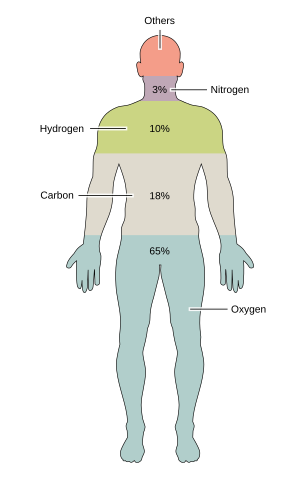Human body
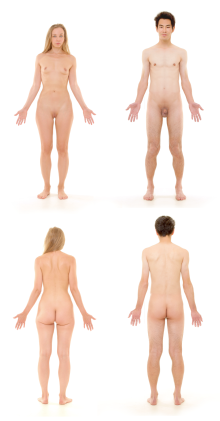
The human body is the entire structure of a
It consists of
The study of the human body includes
The body is studied by health professionals, physiologists, anatomists, and artists to assist them in their work.
Composition
The human body is composed of elements including hydrogen, oxygen, carbon, calcium and phosphorus. These elements reside in trillions of cells and non-cellular components of the body.
The adult male body is about 60%
Cells
The body contains trillions of cells, the fundamental unit of life. At maturity, there are roughly 30 trillion cells, and 38 trillion bacteria in the body,[3][4] an estimate arrived at by totaling the cell numbers of all the organs of the body and cell types. The skin of the body is also host to billions of commensal organisms as well as immune cells.[5] Not all parts of the body are made from cells. Cells sit in an extracellular matrix that consists of proteins such as collagen, surrounded by extracellular fluids.
Genome
Cells in the body function because of
Tissues
The body consists of many different types of
Cells that lie on surfaces exposed to the outside world or gastrointestinal tract (
Organs
Heart
The heart is an organ located in the thoracic cavity between the lungs and slightly to the left. It is surrounded by the pericardium, which holds it in place in the mediastinum and serves to protect it from blunt trauma, infection and help lubricate the movement of the heart via pericardial fluid.[11] The heart works by pumping blood around the body allowing oxygen, nutrients, waste, hormones and white blood cells to be transported.
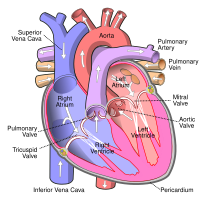
The heart is composed of two atria and two ventricles. The primary purpose of the atria is to allow uninterrupted venous blood flow to the heart during ventricular systole. This allows enough blood to get into the ventricles during atrial systole. Consequently, the atria allows a cardiac output roughly 75% greater than would be possible without them.[12] The purpose of the ventricles is to pump blood to the lungs through the right ventricle and to the rest of the body through the left ventricle.[13]
The heart has an
Coronary artery disease is the leading cause of death worldwide, making up 16% of all deaths.[15] It is caused by the buildup of plaque in the coronary arteries supplying the heart, eventually the arteries may become so narrow that not enough blood is able to reach the myocardium,[16] a condition known as myocardial infarction or heart attack, this can cause heart failure or cardiac arrest and eventually death.[17] Risk factors for coronary artery disease include obesity, smoking, high cholesterol, high blood pressure, lack of exercise and diabetes.[18] Cancer can affect the heart, though it is exceedingly rare and has usually metastasized from another part of the body such as the lungs or breasts. This is because the heart cells quickly stop dividing and all growth occurs through size increase rather than cell division.[19]
Gallbladder
The gallbladder is a hollow pear-shaped organ located
The gallbladder gets its blood supply from the cystic artery, which in most people, emerges from the right hepatic artery.[20]
Gallstones is a common disease in which one or more stones form in the gallbladder or biliary tract. Most people are asymptomatic but if a stone blocks the biliary tract, it causes a gallbladder attack, symptoms may include sudden pain in the upper right abdomen and or center of the abdomen. Nausea and vomiting may also occur. Typical treatment is removal of the gallbladder through a procedure called a cholecystectomy.[21][22] Having gallstones is a risk factor for gallbladder cancer, which although quite uncommon, is rapidly fatal if not diagnosed early.[23]
Systems
- Circulatory system
The
- Digestive system
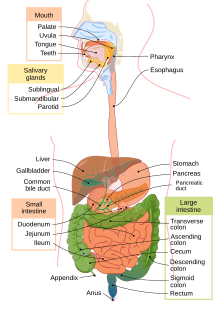
The
Digestion begins in the mouth, which chews food into smaller pieces for easier digestion. Then it is swallowed, and moves through the esophagus to the stomach. In the stomach, food is mixed with gastric acids to allow the extraction of nutrients. What is left is called chyme; this then moves into the small intestine, which absorbs the nutrients and water from the chyme. What remains passes on to the large intestine, where it is dried to form feces; these are then stored in the rectum until they are expelled through the anus.[28]
- Endocrine system
The
- Immune system
The

- Integumentary system
The integumentary system consists of the covering of the body (the skin), including hair and nails as well as other functionally important structures such as the sweat glands and sebaceous glands. The skin provides containment, structure, and protection for other organs, and serves as a major sensory interface with the outside world.[31][32]
- Lymphatic system
The lymphatic system extracts, transports and metabolizes lymph, the fluid found in between cells. The lymphatic system is similar to the circulatory system in terms of both its structure and its most basic function, to carry a body fluid.[33]
- Musculoskeletal system
The
- Nervous system

The
From a structural perspective, the nervous system is typically subdivided into two component parts: the central nervous system (CNS), composed of the brain and the spinal cord; and the peripheral nervous system (PNS), composed of the nerves and ganglia outside the brain and spinal cord. The CNS is mostly responsible for organizing motion, processing sensory information, thought, memory, cognition and other such functions.[36] It remains a matter of some debate whether the CNS directly gives rise to consciousness.[citation needed] The peripheral nervous system (PNS) is mostly responsible for gathering information with sensory neurons and directing body movements with motor neurons.[36]
From a functional perspective, the nervous system is again typically divided into two component parts: the somatic nervous system (SNS) and the autonomic nervous system (ANS). The SNS is involved in voluntary functions like speaking and sensory processes. The ANS is involved in involuntary processes, such as digestion and regulating blood pressure.[37]
The nervous system is subject to many different diseases. In
- Reproductive system
The purpose of the
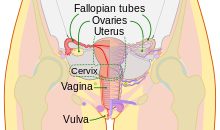
Female puberty generally occurs between the ages of 9 and 13 and is characterized by ovulation and menstruation; the growth of secondary sex characteristics, such as growth of pubic and underarm hair, breast, uterine and vaginal growth, widening hips and increased height and weight, also occur during puberty.[39] Male puberty sees the further development of the penis and testicles.[40]
The female inner sex organs are the two ovaries, their
The male external genitalia include the penis and
Diseases that affect the reproductive system include polycystic ovary syndrome,[43] a number of disorders of the testicles including testicular torsion,[44][45] and a number of sexually transmitted infections including syphilis, HIV, chlamydia, HPV and genital warts. [46][47] Cancer can affect most parts of the reproductive system including the penis, testicles, prostate, ovaries, cervix, vagina, fallopian, uterus and vulva.[48]
- Respiratory system
The
For the respiratory system to function properly, there need to be as few impediments as possible to the movement of air within the lungs. Inflammation of the lungs and excess mucus are common sources of breathing difficulties.[50] In asthma, the respiratory system is persistently inflamed, causing wheezing and/or shortness of breath. Pneumonia occurs through infection of the alveoli, and may be caused by tuberculosis. Emphysema, commonly a result of smoking, is caused by damage to connections between the alveoli.[51]
- Urinary system
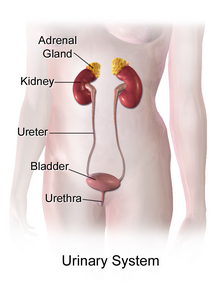
The
First, the
The smooth muscle lining the ureter walls continuously tighten and relax through a process called peristalsis to force urine away from the kidneys and down into the bladder. Small amounts of urine are released into the bladder every 10–15 seconds.
The bladder is a hollow balloon shaped organ located in the pelvis. It stores urine until the brain signals it to relax the urinary sphincter and release the urine into the urethra starting urination.[54] A normal bladder can hold up to 16 ounces (half a liter) for 3–5 hours comfortably.
Numerous diseases affect the urinary system including kidney stones, which are formed when materials in the urine concentrate enough to form a solid mass, urinary tract infections, which are infections of the urinary tract and can cause pain when urinating, frequent urination and even death if left untreated. Renal failure occurs when the kidneys fail to adequately filter waste from the blood and can lead to death if not treated with dialysis or kidney transplantation.[55] Cancer can affect the bladder, kidneys, urethra and ureters, with the latter two being far more rare.[56]
Anatomy
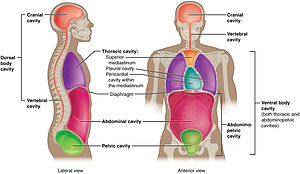
Human anatomy is the study of the shape and form of the human body. The human body has four limbs (two arms and two legs), a head and a neck, which connect to the torso. The body's shape is determined by a strong skeleton made of bone and cartilage, surrounded by fat (adipose tissue), muscle, connective tissue, organs, and other structures. The spine at the back of the skeleton contains the flexible vertebral column, which surrounds the spinal cord, which is a collection of nerve fibres connecting the brain to the rest of the body. Nerves connect the spinal cord and brain to the rest of the body. All major bones, muscles, and nerves in the body are named, with the exception of anatomical variations such as sesamoid bones and accessory muscles.
Blood vessels carry blood throughout the body, which moves because of the beating of the
The body consists of a number of
.Height, weight,
Physiology
Human
Each system contributes to homeostasis, of itself, other systems, and the entire body. Some combined systems are referred to by joint names. For example, the nervous system and the endocrine system operate together as the
Development

Development of the human body is the process of growth to maturity. The process begins with fertilisation, where an egg released from the
Society and culture
Professional study
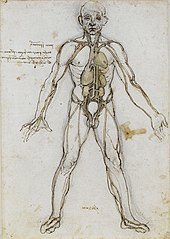
Health professionals learn about the human body from illustrations, models, and demonstrations. Medical and dental students in addition gain practical experience, for example by dissection of cadavers. Human anatomy, physiology, and biochemistry are basic medical sciences, generally taught to medical students in their first year at medical school.[59][60][61]
Depiction
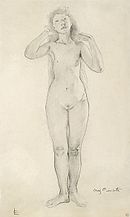
In Western societies, the contexts for depictions of the human body include information, art and pornography. Information includes both science and education, such as anatomical drawings. Any ambiguous image not easily fitting into one of these categories may be misinterpreted, leading to disputes.[62] The most contentious disputes are between fine art and erotic images, which define the legal distinction of which images are permitted or prohibited.
History of anatomy
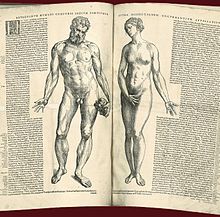
In
History of physiology
The study of human physiology began with
See also
- Anatomical model – Three-dimensional representation of human or animal anatomy
- Body image – Aesthetic perception of one's own body
- Cell physiology – study of cell activity
- Comparative anatomy – Study of similarities and differences in the anatomy of different species
- Comparative physiology – Study of the diversity of functional characteristics of organisms.
- Development of the human body – Process of human growth to maturity
- Glossary of medicine – List of definitions of terms and concepts commonly used in the study of medicine
- Human physical appearance – Look, outward phenotype
- Medicine – Diagnosis, treatment, and prevention of illness
- Organ system
- Outline of human anatomy
- The Birth of the Clinic: An Archaeology of Medical Perception
Human body lists
- List of skeletal muscles of the human body
- List of organs of the human body
- List of distinct cell types in the adult human body
- List of human microbiota
References
- ^ "Fluid Physiology". Anaesthesiamcq. Archived from the original on 3 May 2005. Retrieved 2 September 2016.
- ^ Ganong's 2016, p. 5.
- PMID 27541692.
- PMID 37722043.
- PMID 31743445.
- ^ Ganong's 2016, p. 16.
- ^ "Gene Expression | Learn Science at Scitable". www.nature.com. Archived from the original on 31 October 2010. Retrieved 29 July 2017.
- Oxford Dictionaries| English. Archived from the originalon 5 October 2016. Retrieved 17 September 2016.
- ^ a b Gray's Anatomy 2008, p. 27.
- Collins Dictionary. Retrieved 17 September 2016.
- PMID 27654013.
- ^ Anderson, Robert M. (1999). "Chapter 1: Normal Physiology". The Gross Physiology of the Cardiovascular System (2nd ed.). p. 11.
- ^ "Ventricle | heart". Encyclopedia Britannica. Retrieved 7 August 2021.
- ^ "How the Heart Works". NHLBI, NIH. "Your Heart's Electrical System". Archived from the original on 13 August 2021. Retrieved 7 August 2021.
- ^ "The top 10 causes of death". WHO. 9 December 2020. Retrieved 7 August 2021.
- ^ "Coronary Artery Disease". Centers for Disease Control and Prevention. 19 July 2021. Retrieved 7 August 2021.
- ^ "Heart Attack Symptoms, Risk Factors, and Recovery". Centers for Disease Control and Prevention. 11 January 2021. Retrieved 7 August 2021.
- ^ "Know Your Risk for Heart Disease". Centers for Disease Control and Prevention. 9 December 2019. Retrieved 7 August 2021.
- ^ "Matters of the Heart: Why Are Cardiac Tumors So Rare?". National Cancer Institute. 10 February 2009. Retrieved 7 August 2021.
- ^ PMID 21206646.
- ^ "Gallstones – Symptoms and causes". Mayo Clinic. Retrieved 7 August 2021.
- ^ "Gallstones – Diagnosis and treatment". www.mayoclinic.org. Retrieved 7 August 2021.
- ^ "Gallbladder cancer – Symptoms and causes". Mayo Clinic. Retrieved 7 August 2021.
- U.S. National Cancer Institute. Archived from the originalon 2 February 2007. Retrieved 16 September 2008.
- ISBN 0-13-981176-1.
- ^ "The Cardiovascular System". State University of New York Downstate Medical Center. 8 March 2008. Archived from the original on 11 June 2016. Retrieved 16 September 2008.
- National Institute of Health. Retrieved 4 September 2016.
- ^ a b "Your Digestive System & How it Works". National Institute of Diabetes and Digestive and Kidney Diseases. Retrieved 29 June 2019.
- ^ "Hormonal (endocrine) system". Victoria State Government. Retrieved 4 September 2016.
- LiveScience. Retrieved 4 September 2016.
- ^ Integumentary+System at the U.S. National Library of Medicine Medical Subject Headings (MeSH)
- ISBN 978-0805359107.
- ^ Zimmermann, Kim Anne. "Lymphatic System: Facts, Functions & Diseases". LiveScience. Retrieved 4 September 2016.
- ISBN 978-1-60547-652-0.
- ISBN 978-0-7876-5015-5.
- ^ a b c Horton, James; Bradford, Alina; Zimmermann, Kim Ann (25 March 2022). "Nervous System: Facts, Function & Diseases". livescience.com. Retrieved 8 February 2023.
- ^ "Visual Guide to Your Nervous System". WebMD. Retrieved 8 February 2023.
- ^ "Introduction to the Reproductive System | SEER Training". training.seer.cancer.gov. Retrieved 5 March 2024.
- ^ a b c "Technical Issues In Reproductive Health". www.columbia.edu. Retrieved 7 August 2021.
- ^ "Accessory Glands | SEER Training". www.training.seer.cancer.gov. Retrieved 7 August 2021.
- ^ "Ovaries | SEER Training". www.training.seer.cancer.gov. Retrieved 7 August 2021.
- ^ "External Genitalia | SEER Training". www.training.seer.cancer.gov. Retrieved 7 August 2021.
- PMID 23946629.
- PMID 30288149.)
{{cite journal}}: CS1 maint: DOI inactive as of January 2024 (link - PMID 17137004.
- ^ "Sexually Transmitted Diseases – Information from CDC". www.cdc.gov. 2 August 2021. Retrieved 7 August 2021.
- ^ "CDC – STDs – HPV". www.cdc.gov. 23 June 2021. Retrieved 7 August 2021.
- ^ "Reproductive Cancers | HHS Office of Population Affairs". opa.hhs.gov. Retrieved 7 August 2021.
- ISBN 978-0-13-423435-9.
- ^ a b "Respiratory System". WebMD. Retrieved 8 February 2023.
- ^ Hoffman, Matthew. "Lung Diseases Overview". WebMD. Retrieved 8 February 2023.
- ^ "The Kidneys – a Basic Guide" (PDF). National Health Service. Archived (PDF) from the original on 9 January 2021. Retrieved 7 August 2021.
- ^ "Your Kidneys & How They Work | NIDDK". National Institute of Diabetes and Digestive and Kidney Diseases. Retrieved 7 August 2021.
- ^ "The Urinary Tract & How It Works | NIDDK". National Institute of Diabetes and Digestive and Kidney Diseases. Retrieved 7 August 2021.
- ^ Zimmermann, Kim Ann. "Urinary System: Facts, Functions & Diseases". LiveScience. Retrieved 4 September 2016.
- PMID 28217578.
- ^ Gray, Henry (1918). "Anatomy of the Human Body". Bartleby. Retrieved 4 September 2016.
- ^ a b "What is Physiology?". Understanding Life. Archived from the original on 19 August 2017. Retrieved 4 September 2016.
- ^ "Introduction page, "Anatomy of the Human Body". Henry Gray". 1918. Retrieved 27 March 2007.
- ISBN 0-443-07168-3. Retrieved 27 March 2007.
- ISBN 0-443-07168-3. Archived from the originalon 9 February 2007. Retrieved 27 March 2007.
- S2CID 143370129.
- ^ Gillispie, Charles Coulston (1972). Dictionary of Scientific Biography. Vol. VI. New York: Charles Scribner's Sons. pp. 419–427.
- ^ Nutton, Vivian (12 December 2023). "Galen of Pergamum". Encyclopædia Britannica 2006 Ultimate Reference Suite DVD.
- ^ "Vesalius's De Humanis Corporis Fabrica". Archive.nlm.nih.gov. Retrieved 29 August 2010.
- ^ "Andreas Vesalius (1514–1567)". Ingentaconnect. 1 May 1999. Archived from the original on 5 November 2011. Retrieved 29 August 2010.
- ^ "Microscopic anatomy". Encyclopædia Britannica. Retrieved 14 October 2013.
- McGraw Hill Higher Education. 1998. Archived from the originalon 3 March 2016. Retrieved 25 June 2013.
- PMID 18271159.
- PMC 514597.
- ISBN 978-0-521-34938-3.
- PMID 8010752. Archived from the original(PDF) on 12 April 2021. Retrieved 20 November 2013.
Books
- Boitano, Scott; Brooks, Heddwen L.; Barman, Susan M.; ISBN 978-0-07-182510-8.
- ISBN 978-0-8089-2371-8.
External links
- The Book of Humans (from the late 18th and early 19th centuries) (archived 26 January 2014)
- Inner Body (archived 10 December 1997)
- Anatomia 1522–1867: Anatomical Plates from the Thomas Fisher Rare Book Library

